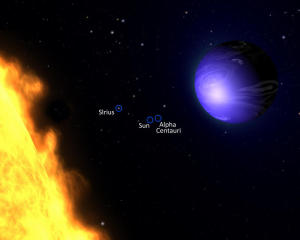
This illustration shows a hot-Jupiter-class planet orbiting its yellow-orange star, HD 189733. NASA's Hubble Space Telescope measured the actual, ...
 This illustration shows a hot-Jupiter-class planet orbiting its yellow-orange star, HD 189733. NASA's Hubble Space Telescope measured the actual visible-light color of the planet, which is deep blue. This color is not due to the presence of oceans, but is caused by the effects of a 2,000-degree-Fahrenheit atmosphere where silicate particles melt to make "raindrops" of glass that scatter blue light more than red light. Because the planet is only 63 light-years from Earth, a visitor would see many of the same stars we see in our nighttime sky, though the constellation patterns would be different. Our Sun and the nearest star to our Sun, Alpha Centauri, appear as two faint stars near image center
This illustration shows a hot-Jupiter-class planet orbiting its yellow-orange star, HD 189733. NASA's Hubble Space Telescope measured the actual visible-light color of the planet, which is deep blue. This color is not due to the presence of oceans, but is caused by the effects of a 2,000-degree-Fahrenheit atmosphere where silicate particles melt to make "raindrops" of glass that scatter blue light more than red light. Because the planet is only 63 light-years from Earth, a visitor would see many of the same stars we see in our nighttime sky, though the constellation patterns would be different. Our Sun and the nearest star to our Sun, Alpha Centauri, appear as two faint stars near image center
If seen directly it would look like a "deep blue dot," reminiscent of Earth's color as seen from space. But that's where all comparison ends. The planet's daytime atmosphere is nearly 2,000 degrees Fahrenheit, and it possibly rains glass -- sideways -- in howling 4,500-mile-per-hour winds.
The cobalt blue color doesn't come from the reflection of a tropical ocean, but rather from a hazy blow-torched atmosphere and perhaps from high clouds laced with silicate particles. The condensation temperature of silicates could form very small drops of glass that would scatter blue light more than red light.
The turbulent alien world, cataloged HD 189733b, is one of the nearest exoplanets to Earth that can be seen crossing the face of its star. It has been intensively studied by Hubble and other observatories, and its atmosphere is dramatically changeable and exotic.
The observations yield new insights into the chemical composition and cloud structure of a bizarre "hot Jupiter" class planet, which orbits precariously close to its parent star.
Clouds often play key roles in planetary atmospheres, and detecting the presence and importance of clouds in hot Jupiters is crucial, say researchers. "We obviously don't know much on the physics and climatology of silicate clouds, so we are exploring a new domain of atmospheric physics," said team member Frederic Pont of the University of Exeter, South West England, the United Kingdom.
The team used Hubble's Space Telescope Imaging Spectrograph to measure changes in the color of light from the planet before, during, and after the passage of the planet behind the parent star. This technique is possible because the planet's orbit is tilted edge-on as viewed from Earth; therefore, it routinely passes in front of and then behind the star.
Hubble measured a small drop in light -- about one part in 10,000 -- when the planet went behind the star, and a slight change in the color of the light, too. "We saw the light becoming less bright in the blue, but not in the green or the red. This means that the object that disappeared is blue because light was missing in the blue, but not in the red when it was hidden," said Pont.
The team's study will be published online July 11 and will appear in the August 1 issue of the Astrophysical Journal Letters.
Earlier observations have reported evidence for the scattering of blue light on the planet. But this most recent Hubble observation gives confirming evidence, said the researchers.
The planet HD 189733b was discovered in 2005. At a distance of only 2.9 million miles from its parent star, the planet is so close that it is gravitationally "tidally locked" so that one side always faces the star and the other side is always dark.
In 2007 NASA's Spitzer Space Telescope measured the infrared light, or heat, from the planet. This observation produced one of the first-ever temperature maps of an exoplanet. The map shows that the dayside and night-side temperatures differ by about 500 degrees Fahrenheit. This temperature difference should cause fierce winds to roar from the daytime to nighttime side. The complementary visible-light Hubble observations reduce contamination from the planet's own hot glow, and focus on atmospheric composition.
Pont cautions that it's difficult to know exactly what causes the color of a planet's atmosphere, even for solar system planets. For example, Jupiter is reddish due to unknown color-carrying molecules. Venus does not reflect ultraviolet (UV) light due to an unknown UV absorber in the atmosphere.
Earth looks blue from space because the oceans absorb red and green wavelengths more strongly than blue light. In addition, the oceans reflect Earth's blue sky where the shorter blue wavelengths of sunlight are selectively scattered by atmospheric oxygen and nitrogen molecules in a process called Rayleigh scattering.

 Previous page
Previous page Back to top
Back to top







